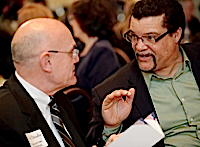 This post has been ruminating with me for a while. It's not a sudden "a-ha" moment that made it form, but a collective group of "a-has!" over the past few months.
This post has been ruminating with me for a while. It's not a sudden "a-ha" moment that made it form, but a collective group of "a-has!" over the past few months.
Consider this the uplifting post to counter last week's "The 11 Harsh Realities Of Entrepreneurship".
innovation DAILY
Here we highlight selected innovation related articles from around the world on a daily basis. These articles related to innovation and funding for innovative companies, and best practices for innovation based economic development.
Mid-Atlantic Region of the Federal Laboratory Consortium
AND
The National Council of Entrepreneurial Tech Transfer (NCET2)
Present
A Webinar Series on
"Demystifying Working with Federal Labs"
Featuring Federal Technology Transfer Professionals
Click Here to Register [or visit http://center.ncet2.org]
SERIES DESCRIPTION:
On April 7, 2010, Office of Science and Technology Policy of the White House released its inaugural Open Government Plan highlighting transparency, participation, and collaboration.
"Demystifying Working with the Federal Labs" is a lecture series launched by the Mid-Atlantic Region of the Federal Laboratory Consortium in order to render the technology transfer process at federal agencies more transparent, and to encourage collaborations with the federal labs. This lecture series aims to provide a platform for Federal Laboratories to educate academia, industry, and technology transfer professionals on different technology transfer mechanisms used at the federal labs. While some of the lectures will be an introduction to common technology transfer mechanisms, such as CRADAs and licenses, other lectures will focus on more specialized agreements that may be unique to a particular agency, such as NASA's Space Act agreements.
It is our hope that the series will encourage a dialogue between the federal laboratories and other stakeholders in the area of technology innovation. We hope to reach small businesses, large businesses, academia, economic development organizations, and technology transfer professionals.
THIS MONTH:
INTERSECTION OF CRADAs AND LICENSING -
FROM THE VANTAGE POINT OF NCI AND NIST
Wednesday, February 16, 2011, 1:00 to 2:30 pm ET
The second lecture in the series will focus on Collaborative Research and Development Agreements and their interplay with licensing. Two seasoned technology transfer professionals will discuss the rights of the CRADA collaborator in the IP developped under the research plan.
Presenters:
Senior CRADA and Licensing Officer
Technology Partnerships Office, NIST
(Click here for more info)
Thomas Clouse
Technology Transfer Specialist,
Technology Transfer Center
National Cancer Institute
(Click here for more info)
Moderated by:
Mojdeh Bahar
Chief, Cancer Branch
Office of Technology Transfer, NIH
(Click here for more info)
COST: Free, but registration required by clicking on the link above.
HOW TO PARTICIPATE?: This series is online. You need a computer with web access for the visual/audio. Q&A is conducted by a chat box to the speakers. Once registered to the webinar series you will receive a separate email with the webinar url 24 hours before the start of the webinar.
WHO SHOULD PARTICIPATE IN THE WEBINAR?: These webinars are open to anyone interested in how federal labs, universities and industry can better work together to foster innovation. This includes university staff, faculty and students, local and state economic development professionals, corporate business development directors, academic liaisons, corporate, academic and federal laboratory researchers, technology transfer professionals, and service providers (e.g. lawyers, consultants).
Coming to the rescue of the EU's innovation emergency | EurActiv
 There is an innovation emergency in Europe and a huge amount of work lies ahead if the EU is to close the innovation gap with competitors the US and Japan, writes Jonathan Zuck, president of the Association for Competitive Technology, in an exclusive commentary for EurActiv.
There is an innovation emergency in Europe and a huge amount of work lies ahead if the EU is to close the innovation gap with competitors the US and Japan, writes Jonathan Zuck, president of the Association for Competitive Technology, in an exclusive commentary for EurActiv.
There’s no room for common sense in startups | VentureBeat
 Let’s say you’ve decided to provide something tremendously fantastic for your customers, even though it meant great expense and hardship. It would be incontrovertible — you’d refuse to compromise on that one thing, even if it seems impossible to work out how to do it profitably.
Let’s say you’ve decided to provide something tremendously fantastic for your customers, even though it meant great expense and hardship. It would be incontrovertible — you’d refuse to compromise on that one thing, even if it seems impossible to work out how to do it profitably.
It’s easy to identify companies who became wildly successful with this technique. Of course this is survivor bias at it’s finest; these examples don’t prove this is a great strategy, they just illustrate that it can work:
Chuck Patterson stuns surfing world by skiing massive waves
 Chuck Patterson had grown up skiing dangerous big-mountain terrain; he had also surfed plenty of large, thunderous waves.
Chuck Patterson had grown up skiing dangerous big-mountain terrain; he had also surfed plenty of large, thunderous waves.
But never, until recently, had he or anyone else donned skis and used them to surf the gargantuan swells at a notoriously treacherous spot called Jaws, off the Hawaiian island of Maui.
Ready, Set, Go! Innovators Set the Pace in the Race for Faster Cures - Knowledge@Wharton
 A new model for developing cures is winning battles in the war against disease in laboratories, clinics and research centers around the world. The hallmarks of this movement are collaboration and the sharing of intellectual property in a wide-open manner that cuts against the grain of traditional for-profit drug discovery.
A new model for developing cures is winning battles in the war against disease in laboratories, clinics and research centers around the world. The hallmarks of this movement are collaboration and the sharing of intellectual property in a wide-open manner that cuts against the grain of traditional for-profit drug discovery.
The new initiatives take many forms. Some target conditions ranging from Alzheimer's to tuberculosis through alliances of foundations, nonprofits, universities, corporations and government agencies. Others make years of research available at the click of a mouse button to scientists around the world. Still others are carving out new financial and regulatory paths for bringing drugs to market at an accelerated pace.
1,000 New York City Entrepreneurs Started and Grew Their Businesses with the Help of the Kauffman FastTrac® Education Programs

10 Fastest Growing Jobs in the Next Decade - Derek Thompson - Business - The Atlantic
 Health care will dominate job creation in the next decade, and employment opportunities for college educated workers will grow nearly twice as fast as jobs for high school graduates, according to comprehensive projections from the Bureau of Labor Statistics.
Health care will dominate job creation in the next decade, and employment opportunities for college educated workers will grow nearly twice as fast as jobs for high school graduates, according to comprehensive projections from the Bureau of Labor Statistics.
"The fastest growing jobs are mostly in health care and consulting," said Michael Wolf, an economist with BLS, which originally produced this report in 2008. "The fastest declining sectors are in low-skill manufacturing with apparel, textiles and fabrics."
The 4 'Metaforces' Driving the Next Economy - Derek Thompson - Business - The Atlantic
 Washington likes to play guessing games with the economy, placing bets on certain industries by supplying them with luxurious tax giveaways or no-fault loans. But the jobs of the future are at the mercy of giant, global forces that are largely out of our control. To get a feel for the known unknowns, I spoke with Bruce Katz, director of the Brookings Metropolitan Policy Program, on the metaforces driving the next economy. He named four.
Washington likes to play guessing games with the economy, placing bets on certain industries by supplying them with luxurious tax giveaways or no-fault loans. But the jobs of the future are at the mercy of giant, global forces that are largely out of our control. To get a feel for the known unknowns, I spoke with Bruce Katz, director of the Brookings Metropolitan Policy Program, on the metaforces driving the next economy. He named four.
1. Global Demand. In the 20th century, the United States was the world's top producer and consumer. But as China and India join the global middle class with a combined population eight times the size of the U.S. (and that's not to mention their fast-charging cousins, like Brazil and Indonesia), the new slogan for successful companies will be "Go East Young Man." Firms that can open overseas wallets will see the highest gains in productivity, wages and growth.
The Seven Deadly Sins That Choke Out Innovation | Co.Design
 In most companies, there's a profound tension between the right-brainers (for lack of a better term) espousing design, design thinking and user-centered approaches to innovation and the left-brained, more spreadsheet-minded among us. Most C-suites are dominated by the latter, all of whom are big fans of nice neat processes and who pay good money to get them implemented rigorously. So often, the innovation process is treated as a simple, neat little machine. Put in a little cash and install the right process, and six months later, out pops your new game-changing innovation -- just like toast, right from the toaster. But that, of course, is wrong.
In most companies, there's a profound tension between the right-brainers (for lack of a better term) espousing design, design thinking and user-centered approaches to innovation and the left-brained, more spreadsheet-minded among us. Most C-suites are dominated by the latter, all of whom are big fans of nice neat processes and who pay good money to get them implemented rigorously. So often, the innovation process is treated as a simple, neat little machine. Put in a little cash and install the right process, and six months later, out pops your new game-changing innovation -- just like toast, right from the toaster. But that, of course, is wrong.
Angel Investor Bill Payne: Due Diligence Is So Yesterday – NOT! | Venture Hype
 You just read another story on how quickly certain angels invest and you’re secretly admiring their ability to make decisions on the spot. Now you’re thinking: Due diligence is SO yesterday. Screw it and close more deals already!
You just read another story on how quickly certain angels invest and you’re secretly admiring their ability to make decisions on the spot. Now you’re thinking: Due diligence is SO yesterday. Screw it and close more deals already!
Do what you want; you’re investing your own money, not ours. But first, check out our interview with Bill Payne, Angel of the Year in 2009. You might rethink your “strategy.”
Leadership for Networks
 It takes different leadership to increase collaboration and support social learning in the workplace. Leadership is the key, not technology. Most of our leadership practices come from a command and control military legacy that have been adopted by the business world for the past century. But hierarchies don’t help us manage in networks, whether they be social, value or organizational networks. Steve Denning explains:
It takes different leadership to increase collaboration and support social learning in the workplace. Leadership is the key, not technology. Most of our leadership practices come from a command and control military legacy that have been adopted by the business world for the past century. But hierarchies don’t help us manage in networks, whether they be social, value or organizational networks. Steve Denning explains:
Saying that hierarchies are needed is like arguing for smoking cigarettes. Hierarchies are a harmful habit that we need to break. We may be addicted to them, so that breaking the habit is hard, but the way forward is clear.
Is Crowdfunding Working? Here’s What We Know | paidContent
 Crowdfunding’s growing up.
Crowdfunding’s growing up.
On one such site, 13,512 people recently raised nearly $1 million for a Chicago designer. And fan-funding sites are now bankrolling albums from established music acts, not just dodgy indie bands.
But just how much are these services making for members, and for themselves?
I’ve spent the last few weeks collecting data on the sector, by talking with all the main crowdfunding platforms…
My conclusion: an estimated $80 million has been pledged through these sites, by fewer than a million supporters. But not everyone gets funded, and returns for the sites themselves appear modest.
IT'S OFFICIAL: The Smartphone Market Is Now Bigger Than The PC Market
 Well, that was fast.
Well, that was fast.
Only three years after the iPhone launched, the smartphone market is already bigger than the PC market.
According to IDC, 101 million smartphones were sold in Q4, versus 92 million PCs.
Smartphone shipments, meanwhile, grew 87% year over year, while PCs only grew 3%.
10 Tips for Working with Outside Experts
 May I call it the expertise business? As a provider, I made a good living with business planning consulting on my own for 11 years and as an employee of larger consulting companies for nine years. As a client, I’ve worked with some excellent attorneys, some good and not-so-good accountants, and good and not-so-good package designers, copywriters, graphic artists, and public relations consultants. And I’d like to suggest some tips for buyers of expertise, to help you get what you pay for.
May I call it the expertise business? As a provider, I made a good living with business planning consulting on my own for 11 years and as an employee of larger consulting companies for nine years. As a client, I’ve worked with some excellent attorneys, some good and not-so-good accountants, and good and not-so-good package designers, copywriters, graphic artists, and public relations consultants. And I’d like to suggest some tips for buyers of expertise, to help you get what you pay for.
1. Map the different species. Different experts have different standard behaviors. Some experts do the work for you, some tell you what to do, some help you do it. Some are obvious, like the accountant filling out the tax forms for you, the lawyers writing the legal documents, the designers designing, and the graphic artists drawing. But the lines get blurry. Accountants and lawyers, for example, don’t just do things, they also give advice and charge you for it. Coaches and consultants have some obvious differences. Know who does what.
Boomers are Driving a New Entrepreneurship Boom
 Contrary to what most of you might guess, the highest rate of entrepreneurial activity over the last few years is not Gen-Y young upstarts, but Baby Boomers in the 55-64 year age group. In fact, according to a study by the Ewing Marion Kauffman Foundation, these Boomers are actually driving a new entrepreneurship boom.
Contrary to what most of you might guess, the highest rate of entrepreneurial activity over the last few years is not Gen-Y young upstarts, but Baby Boomers in the 55-64 year age group. In fact, according to a study by the Ewing Marion Kauffman Foundation, these Boomers are actually driving a new entrepreneurship boom.
Some people are calling entrepreneurship the ‘new mid-life crisis’ for the 76 million-strong demographic once thought to be over the hill. Partially due to the economy, but also due to longer, healthier lives and changes in job tenure, 62% of working Boomers are now expected to stay in the labor force, with real power and influence, for at least nine more years, to 2020.
Here is a summary of indicative facts from the earlier study referenced, an update published last year, and others. These indicate that the correct icon for an entrepreneur may now have gray hair, rather than the warm glow of youth:
The State of Entrepreneurship: Will Entrepreneurs Increase Hiring and Contribute to GDP Growth in 2011?

 (WASHINGTON), Feb. 8, 2011 – Following President Obama's increased focus on regulatory reform and his call for innovation during the State of the Union Address, and on the heels of the Startup America Partnership launched last week, Carl Schramm, president and CEO of the Ewing Marion Kauffman Foundation, today urged policymakers to adopt specific rule changes that will accelerate economic growth through innovation and entrepreneurship. At the second annual Kauffman State of Entrepreneurship Address, titled "The Rules for Growth," Schramm cited data illustrating that the majority of all job creation in the United States is driven by young firms and emphasized how changes to specific laws and regulations could enable startups to grow more rapidly without adding to the deficit.
(WASHINGTON), Feb. 8, 2011 – Following President Obama's increased focus on regulatory reform and his call for innovation during the State of the Union Address, and on the heels of the Startup America Partnership launched last week, Carl Schramm, president and CEO of the Ewing Marion Kauffman Foundation, today urged policymakers to adopt specific rule changes that will accelerate economic growth through innovation and entrepreneurship. At the second annual Kauffman State of Entrepreneurship Address, titled "The Rules for Growth," Schramm cited data illustrating that the majority of all job creation in the United States is driven by young firms and emphasized how changes to specific laws and regulations could enable startups to grow more rapidly without adding to the deficit.
Kauffman also released today its groundbreaking new book, Rules for Growth, which features comprehensive essays prescribing a new set of policies for policymakers, legal scholars, economists and business leaders to accelerate economic growth and innovation.
 The policies discussed here today are meant to serve as a roadmap for policymakers who want to help create the conditions that will contribute to higher rates of innovation and growth, improved living standards and better lives for people in the United States and throughout the world," said Schramm. "These efforts will require a thoughtful re-examination of how laws and institutions affect economic growth and the types of adjustments we can make as a nation to incubate high-growth firms."
The policies discussed here today are meant to serve as a roadmap for policymakers who want to help create the conditions that will contribute to higher rates of innovation and growth, improved living standards and better lives for people in the United States and throughout the world," said Schramm. "These efforts will require a thoughtful re-examination of how laws and institutions affect economic growth and the types of adjustments we can make as a nation to incubate high-growth firms."
People Are Awesome: Look at Hundreds of Volunteers Help Hydrate Beached Whales - Culture - GOOD
 When dozens of pilot whales got stranded on a beach in New Zealand last week, "droves" of volunteers and professionals from the Department of Conservation teamed up to help move the animals back into the ocean. But just days later, 65 of the whales had again beached themselves. This time, not only did hundreds more volunteers show up, they stayed with the whales, hydrating them for hours until the tide rose and the whales could move themselves back to sea.
When dozens of pilot whales got stranded on a beach in New Zealand last week, "droves" of volunteers and professionals from the Department of Conservation teamed up to help move the animals back into the ocean. But just days later, 65 of the whales had again beached themselves. This time, not only did hundreds more volunteers show up, they stayed with the whales, hydrating them for hours until the tide rose and the whales could move themselves back to sea.
TEDCO Completes Ft. Detrick Technology Transfer Initiative - Citybizlist
 COLUMBIA, Md. -- The Maryland Technology Development Corporation (TEDCO), in collaboration with the Frederick County Office of Economic Development (OED), announced today the successful completion of the Ft. Detrick Technology Transfer Initiative (FDTTI) and three final grant awardees. Through the FDTTI program, 26 startup companies received a total of $1,300,000 for the development of technology solutions used to address medical needs of the U.S. Army. The final companies to receive funding are Oculearn, LLC, Fyodor Biotechnologies, Inc., and Foxspire, LLC. Each research team received $50,000.
COLUMBIA, Md. -- The Maryland Technology Development Corporation (TEDCO), in collaboration with the Frederick County Office of Economic Development (OED), announced today the successful completion of the Ft. Detrick Technology Transfer Initiative (FDTTI) and three final grant awardees. Through the FDTTI program, 26 startup companies received a total of $1,300,000 for the development of technology solutions used to address medical needs of the U.S. Army. The final companies to receive funding are Oculearn, LLC, Fyodor Biotechnologies, Inc., and Foxspire, LLC. Each research team received $50,000.

